Report on the Business Value of Preventive Health
2024
→
Taking On Longevity with Market Innovation

We develop initiatives that focus on meeting the challenges of worldwide aging with groundbreaking market solutions and progressive public policies.
Through our white papers, roundtables, webinars, presentations to third parties, and other communications materials, we are leading the global aging dialogue and providing public education designed to enable healthier and more active aging.

2024
→
Growing evidence suggests that employers across size, sector, and industry types are now recognizing support for their employees’ health as a “must have,” or, to be more precise, “a must offer.” In these calculations, preventive care has become a key priority for the workforce, not least because of the parallel benefits to the employer.
 This new GCOA paper, launched ahead of Silver Economy Forum 2024, examines how industry leaders are creating business value, engaging their workforce, improving productivity and economic value, and advancing top private-sector priorities by taking action on preventive health for their employees through employee benefits and policies, such as supporting access to adult immunization, mental health supports, and health screenings. The paper outlines how companies like Amazon, Amgen, Bank of America, Biogen, British Airways, Citibank, Dell, Edwards, Google, IBM, and Microsoft have made robust efforts to embrace employee health and well-being.
This new GCOA paper, launched ahead of Silver Economy Forum 2024, examines how industry leaders are creating business value, engaging their workforce, improving productivity and economic value, and advancing top private-sector priorities by taking action on preventive health for their employees through employee benefits and policies, such as supporting access to adult immunization, mental health supports, and health screenings. The paper outlines how companies like Amazon, Amgen, Bank of America, Biogen, British Airways, Citibank, Dell, Edwards, Google, IBM, and Microsoft have made robust efforts to embrace employee health and well-being.
2024
→
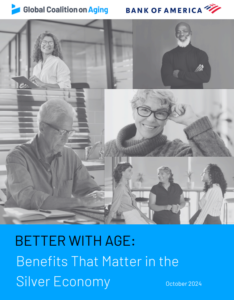 As global populations age, the need for businesses to recruit and retain older workers becomes increasingly vital. This new report, together with GCOA member Bank of America, explores the importance of embracing this demographic shift, not only to combat ageism but also to enhance organizational success and foster healthier communities.
As global populations age, the need for businesses to recruit and retain older workers becomes increasingly vital. This new report, together with GCOA member Bank of America, explores the importance of embracing this demographic shift, not only to combat ageism but also to enhance organizational success and foster healthier communities.
Employee benefits packages, including health insurance, retirement plans, and flexible work arrangements, are crucial tools for attracting and retaining older talent. By offering tailored benefits—such as caregiving leave, phased retirement, and financial planning support—employers can extend careers, leverage the unique expertise of older workers, and ensure sustained productivity.
This report highlights best practices for creating an age-inclusive environment, demonstrating how businesses can build comprehensive benefits that support both personal and professional well-being, resulting in a healthier, more engaged workforce.
2024
→
On World Ageism Day 2024, GCOA launched a new report highlighting the role of ageism as a social determinant of health, illustrated through the example of heart valve disease. As outlined in the paper, The Health and Economic Costs of Ageism as a Social Determinant of Health: The Case of Heart Valve Disease, ageism results in underdiagnosis and undertreatment of conditions like heart valve disease, where timely intervention can dramatically improve outcomes and lead to significant cost savings for health systems and society.
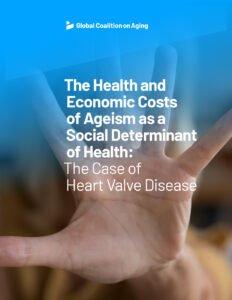 Despite tremendous scientific innovation and the availability of advanced treatments, ageist systems, attitudes, and beliefs continue to place countless lives at unnecessary risk by preventing timely access to care and treatment. The paper shares evidence of ageism’s impact on health outcomes and system costs and outlines concrete steps for stakeholders to take in the fight against ageism, unlocking the full benefit of innovation for individuals and their families, healthcare systems, and society at large.
Despite tremendous scientific innovation and the availability of advanced treatments, ageist systems, attitudes, and beliefs continue to place countless lives at unnecessary risk by preventing timely access to care and treatment. The paper shares evidence of ageism’s impact on health outcomes and system costs and outlines concrete steps for stakeholders to take in the fight against ageism, unlocking the full benefit of innovation for individuals and their families, healthcare systems, and society at large.
2024
→
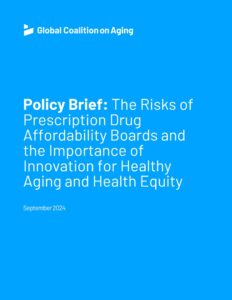 On June 6, 2024, The Global Coalition on Aging (GCOA) Alliance for Health Innovation convened a roundtable discussion of cross-sectoral experts representing patients, caregivers, academia, biopharmaceutical innovators, and business communities to discuss Prescription Drug Affordability Boards (PDABs), Upper Payment Limits (UPLs), and the risk they pose to the innovation that is needed to safeguard healthy aging and improve health equity.
On June 6, 2024, The Global Coalition on Aging (GCOA) Alliance for Health Innovation convened a roundtable discussion of cross-sectoral experts representing patients, caregivers, academia, biopharmaceutical innovators, and business communities to discuss Prescription Drug Affordability Boards (PDABs), Upper Payment Limits (UPLs), and the risk they pose to the innovation that is needed to safeguard healthy aging and improve health equity.
This brief builds on two previous GCOA Alliance for Health Innovation policy briefs—the first from June 2023 on healthy aging and innovation, and the second from September 2023 on the intersection of healthy aging, innovation, and oncology – and highlights the themes that emerged from the roundtable discussion, including patient concerns with PDABs and recommended best practices for patient engagement in States that have implemented or are considering the implementation of PDABs and UPLs.
Key Takeaways:
The Global Coalition on Aging Alliance for Health Innovation brings together over 20 patient advocacy organizations, scientists, and policy specialists to establish awareness of the importance of innovation in achieving healthy aging through investments, policy reforms, and strategic partnerships – both for the value to patients and for health system sustainability.
2024
→
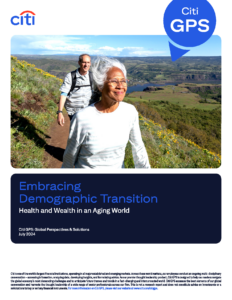
The Global Coalition on Aging is proud to contribute to Citi Global Perspectives & Solutions’ (GPS) July 2024 report, Embracing Demographic Transition: Health and Wealth in an Aging World. CEO Michael Hodin and Executive Director Melissa Mitchell authored the report’s conclusion.
Citi GPS collated perspectives from across Citi and its global network to explore how society’s extra years of life expectancy can be lived as social contributors rather than dependents. From these expert contributions, Citi finds that supporting the health and wealth of an aging population are the levers to pull if our aim is to minimize the dependence of an aging population. Citi sees four dimensions:
Read the full report here.
2024
→
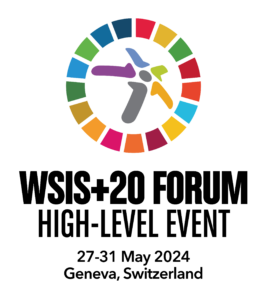 At the World Summit on the Information Society, May 30, 2024, GCOA hosted a panel discussion on the global health crisis that is AMR and how technology can, should and will have an impact through diagnostics, surveillance, and innovative developments. AMR will be responsible for 10 million deaths annually by 2050 – on track to be more deadly than cancer. AMR makes even the most common medical procedures, such as knee replacements, cancer treatments, root canals and caesarian sections, risky or even deadly, and those most vulnerable are in lesser developed countries. Click here for the Outcome Report. You can watch the panel here.
At the World Summit on the Information Society, May 30, 2024, GCOA hosted a panel discussion on the global health crisis that is AMR and how technology can, should and will have an impact through diagnostics, surveillance, and innovative developments. AMR will be responsible for 10 million deaths annually by 2050 – on track to be more deadly than cancer. AMR makes even the most common medical procedures, such as knee replacements, cancer treatments, root canals and caesarian sections, risky or even deadly, and those most vulnerable are in lesser developed countries. Click here for the Outcome Report. You can watch the panel here.
The panel included the participation of Ms. Latifat Okara, Principal and Americas Regional Lead, Economist Impact; John-Louis Tissier, Vice President Government and Public Affairs, bio-Mérieux: Dr. Raghu Sriram, Scientist, World Health Organization (WHO ) and Pol Vandenbroucke, Vice President Global Government Affairs, Shionogi, who served as the moderator. You can read more about the panel on our blog. For the WSIS official page, click here.
2024
→
We are thrilled to announce this year’s Silver Economy Forum will be in-person and broadcast live from Berlin, Germany on October 16. The Global Coalition on Aging is pleased to partner with the American Council on Germany for this year’s Forum.
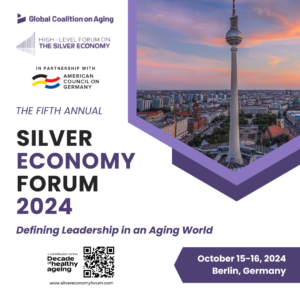 Now in its fifth year, SEF 2024 will highlight key themes at the intersection of leadership, successful aging, and the Silver Economy, including healthcare and finance challenges, technology’s impact on aging, the core elements in an age-friendly environment, and the future of traditional consumer businesses. Linking these themes to the goals and aspirations of the UN Decade of Healthy Ageing and the Sustainable Development Goals (SDGs), GCOA and ACG will dive into what businesses and countries must do to stay competitive in a rapidly aging and changing society and how intergenerational workforces can impact the success of the global workplace.
Now in its fifth year, SEF 2024 will highlight key themes at the intersection of leadership, successful aging, and the Silver Economy, including healthcare and finance challenges, technology’s impact on aging, the core elements in an age-friendly environment, and the future of traditional consumer businesses. Linking these themes to the goals and aspirations of the UN Decade of Healthy Ageing and the Sustainable Development Goals (SDGs), GCOA and ACG will dive into what businesses and countries must do to stay competitive in a rapidly aging and changing society and how intergenerational workforces can impact the success of the global workplace.
2024
→
In April 2024, GCOA convened the private workshop of experts and officials from Japan, Canada, the United Kingdom, Italy, the European Union, and the United States to discuss the need for action on the implementation of pull incentives – a policy option that could address the critical need for new antimicrobials – across both the G7 and European Union, as well as globally.
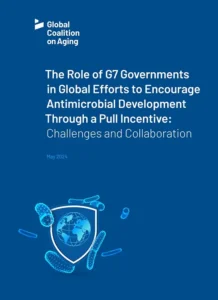 At the meeting and in the report that followed, “The Role of G7 Governments in Global Efforts to Encourage Antimicrobial Development Through a Pull Incentive: Challenges and Collaboration,” leaders called on G7 governments to fund pull incentives and make “fair share” investments in antibiotic innovation to fight the global antimicrobial resistance (AMR) crisis.
At the meeting and in the report that followed, “The Role of G7 Governments in Global Efforts to Encourage Antimicrobial Development Through a Pull Incentive: Challenges and Collaboration,” leaders called on G7 governments to fund pull incentives and make “fair share” investments in antibiotic innovation to fight the global antimicrobial resistance (AMR) crisis.
They found that:
In September, countries will gather for the 2024 UNGA High-Level Meeting on AMR, where they have the opportunity to put the findings of this report into place.
The roundtable and report, available in both English and Japanese, were funded by the Japanese Pharmaceutical Manufacturer’s Association (JPMA).
2024
→
In January 2024, the Global Coalition on Aging convened a group of preeminent experts from various fields including infectious diseases, population aging, economics, advocacy, caregiving, and policy for a roundtable discussion on RSV. The aim of the roundtable was to share local and international insights on the impact, gaps, and opportunities to better address RSV in the Asia-Pacific region, including the role of surveillance and data monitoring, public health education, and the importance of prevention.
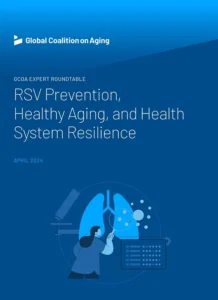 Respiratory infections like influenza, RSV (respiratory syncytial virus), and now COVID-19, among others, place a substantial and growing burden on health systems. Among these three infections—responsible for the so called “tripledemic”—RSV is the least recognized. There is low awareness of RSV among healthcare professionals and the general public and little understanding of the disease burden and impact in older adults globally, but particularly in the Asia-Pacific region—which is rapidly aging.
Respiratory infections like influenza, RSV (respiratory syncytial virus), and now COVID-19, among others, place a substantial and growing burden on health systems. Among these three infections—responsible for the so called “tripledemic”—RSV is the least recognized. There is low awareness of RSV among healthcare professionals and the general public and little understanding of the disease burden and impact in older adults globally, but particularly in the Asia-Pacific region—which is rapidly aging.
This report, released in April 2024, shares four key takeaways from this roundtable, culminating in a set of calls to action, including the need to establish a an Asia-Pacific RSV consortium to enhance data surveillance and support planning and decision-making in the region.
2024
→
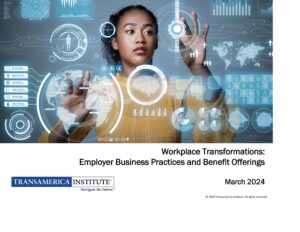 A March 2024 report from the Transamerica Center for Retirement Studies (TCRS) in collaboration with Transamerica Institute finds that almost seven in ten employers either currently or plan to use robotics or artificial intelligence to augment their human workforce. The report, Workplace Transformations: Employer Business Practices and Benefit Offerings, is based on a survey of 1,873 employers of for-profit companies.“Robotics and artificial intelligence may be revolutionizing the business world, but human workers are still critically needed. Many employers are feeling the pain of the prolonged labor crunch. Those with innovative and robust benefit offerings have an edge in the competition for talent,” said Catherine Collinson, CEO and president of Transamerica Institute and TCRS. The report analyzes companies by size and uses contextual comparisons with Transamerica Institute’s most recent survey of workers.
A March 2024 report from the Transamerica Center for Retirement Studies (TCRS) in collaboration with Transamerica Institute finds that almost seven in ten employers either currently or plan to use robotics or artificial intelligence to augment their human workforce. The report, Workplace Transformations: Employer Business Practices and Benefit Offerings, is based on a survey of 1,873 employers of for-profit companies.“Robotics and artificial intelligence may be revolutionizing the business world, but human workers are still critically needed. Many employers are feeling the pain of the prolonged labor crunch. Those with innovative and robust benefit offerings have an edge in the competition for talent,” said Catherine Collinson, CEO and president of Transamerica Institute and TCRS. The report analyzes companies by size and uses contextual comparisons with Transamerica Institute’s most recent survey of workers.
2024
→
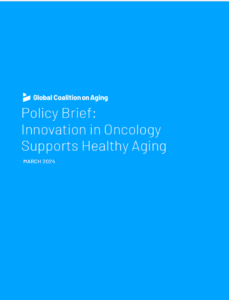 On September 27, 2023, The Global Coalition on Aging (GCOA) Alliance for Health Innovation and The American Federation for Aging Research (AFAR) convened for a roundtable discussion on cancer, innovation, and healthy aging. Experts on cancer treatment, health policy, aging, and patient voices explored the value of biomedical innovation, and the importance of both the availability and accessibility of innovative treatments, with a focus on oncology, as a prerequisite for healthy aging.
On September 27, 2023, The Global Coalition on Aging (GCOA) Alliance for Health Innovation and The American Federation for Aging Research (AFAR) convened for a roundtable discussion on cancer, innovation, and healthy aging. Experts on cancer treatment, health policy, aging, and patient voices explored the value of biomedical innovation, and the importance of both the availability and accessibility of innovative treatments, with a focus on oncology, as a prerequisite for healthy aging.
This policy brief highlights the themes that emerged from the roundtable discussion and provides key policy recommendations to ensure equitable access to future biomedical innovations and contribute to healthy aging for all that can be applied not only to oncology, but also the broader biomedical innovation ecosystem within the United States:
The Global Coalition on Aging Alliance for Health Innovation brings together over 20 patient advocacy organizations, scientists, and policy specialists to establish awareness of the importance of innovation in achieving healthy aging through investments, policy reforms, and strategic partnerships – both for the value to patients and for health system sustainability.
2024
→
Why an Age-Friendly City or Community Has to Address Osteoporosis
 Good bone health improves strength and mobility for greater independence and increased wellbeing among older adults. A bone health program is a smart investment, ensuring that older adults can live happier and healthier lives in their communities.
Good bone health improves strength and mobility for greater independence and increased wellbeing among older adults. A bone health program is a smart investment, ensuring that older adults can live happier and healthier lives in their communities.
The Global Coalition on Aging Bone Health Initiative’s new guide for age-friendly cities and communities provides an overview of challenge poor bone health presents for age-friendly cities and communities, why it’s critical to act to address bone health, and provides guidelines for age-friendly cities and communities to develop their own bone health programs.
2024
→
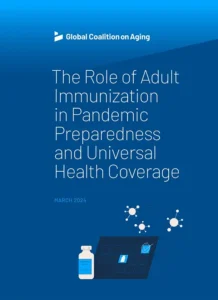 On September 19th, 2023, the Global Coalition on Aging (GCOA), the International Longevity Centre UK (ILC-UK), and the International Longevity Centre USA (ILC-USA) convened a roundtable discussion alongside the 2023 UNGA High Level Meeting to discuss the essential role that life-course immunization should play in pandemic preparedness.
On September 19th, 2023, the Global Coalition on Aging (GCOA), the International Longevity Centre UK (ILC-UK), and the International Longevity Centre USA (ILC-USA) convened a roundtable discussion alongside the 2023 UNGA High Level Meeting to discuss the essential role that life-course immunization should play in pandemic preparedness.
The discussion brought together experts on healthy aging, pharmacology, drug and vaccine development, physicians, and policy experts to consider:
This policy brief outlines three key recommendations that emerged from the expert discussion.
2024
→
Held in New York City on December 6 and 7, 2023, Silver Economy Forum 2023: Aging For All Ages looked at the growing global Silver Economy through a multigenerational lens. The 2023 Forum focused on the emerging awareness that information and action on aging – health, financial and lifestyle – brings incremental value the earlier in life it is pursued, leading to the most impactful benefits for people, societies, and governments.
Linking to the goals and aspirations of the UN Decade of Healthy Ageing, SEF 2023 highlighted key themes at the intersection of aging at every age and the Silver Economy, including a life course approach to disease prevention, health systems resilience, the multigenerational workforce and workplace, health equity, caregiving, digital technology, the value of biomedical innovation and the future of age-friendly communities.
Guest speakers included noted representatives from international organizations, leaders in business and government, scientists and academicians as well as civil servants that are leading developments at a grass-roots level. For more information and to see video from the sessions, please visit the Silver Economy Forum website.
2024
→
Released in February 2024, in the lead up to the United Nations General Assembly 2024 High-level Meeting on Antimicrobial Resistance (AMR) in September, the 2024 AMR Preparedness Index Progress Report assesses how the eleven largest global economies have advanced on calls to action laid out in the 2021 AMR Preparedness Index.
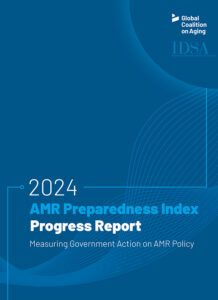 The new 2024 Progress Report assesses the same eleven countries as the 2021 Index: Brazil, Canada, China, France, Germany, India, Italy, Japan, South Korea, the United Kingdom (UK), and the United States (US). The 2021 Index examined over 100 metrics to evaluate and rank countries’ performance against AMR and establish benchmarks for policy action and leadership.
The new 2024 Progress Report assesses the same eleven countries as the 2021 Index: Brazil, Canada, China, France, Germany, India, Italy, Japan, South Korea, the United Kingdom (UK), and the United States (US). The 2021 Index examined over 100 metrics to evaluate and rank countries’ performance against AMR and establish benchmarks for policy action and leadership.
Across indicators, the 2024 Progress Report found that more needs to be done to put a firm halt to the spread of AMR, including the following points:
Both the AMR Preparedness Index and the 2024 Progress Report were created in partnership with the Infectious Diseases Society of America and supported by the International Federation of Pharmaceutical Manufacturers and Associations (IFPMA).
2024
→
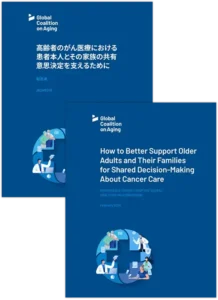 On October 12th, 2023, the Global Coalition on Aging convened an expert roundtable that brought together healthcare providers, clinicians, patient representatives, and academics from Japan, the United States, Canada, Ireland, and the United Kingdom to discuss How to Better Support Older Adults and Their Families for Shared Decision-Making About Cancer Care. This discussion was prompted by recent policy changes in Japan that aim to improve cancer care for older adults through the integration of shared decision-making into the care system, but SDM is applicable across health systems worldwide.
On October 12th, 2023, the Global Coalition on Aging convened an expert roundtable that brought together healthcare providers, clinicians, patient representatives, and academics from Japan, the United States, Canada, Ireland, and the United Kingdom to discuss How to Better Support Older Adults and Their Families for Shared Decision-Making About Cancer Care. This discussion was prompted by recent policy changes in Japan that aim to improve cancer care for older adults through the integration of shared decision-making into the care system, but SDM is applicable across health systems worldwide.
SDM is the process by which medical providers, patients, and patients’ families come together to develop mutually agreed upon, informed plans for cancer care. SDM can help healthcare systems better attend to the diverse needs of older cancer patients, leading to improved patient outcomes and healthier aging.
This report shares insights and key takeaways from the expert discussion, as well as recommendations on how to implement and expand upon SDM practices.
2024
→
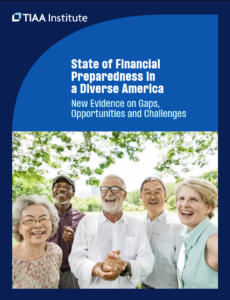 This new report from TIAA Institute sheds light on how Americans across demographic groups are making decisions about retirement, and what people’s attitudes and experiences today suggest for our nation’s financial future. The report examines big-picture decisions like when to retire and what to do in retirement, but also tactical decisions with significant implications—when to start saving, how to save and how much to save. This research informs efforts underway to address America’s retirement crisis and close equity gaps.
This new report from TIAA Institute sheds light on how Americans across demographic groups are making decisions about retirement, and what people’s attitudes and experiences today suggest for our nation’s financial future. The report examines big-picture decisions like when to retire and what to do in retirement, but also tactical decisions with significant implications—when to start saving, how to save and how much to save. This research informs efforts underway to address America’s retirement crisis and close equity gaps.
Key insights include:
2024
→
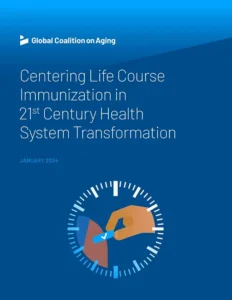 On June 12, 2023, the Global Coalition on Aging organized a panel session at the International Association of Gerontology and Geriatrics Asia/Oceania Regional Congress 2023. The session brought together experts from aging and elder care, including from the World Health Organization, for a discussion on the importance of life course immunization and the need for health systems to shift towards a focus on prevention and the growing role for integrated person-centered care. This transformation of health systems, including a greater prioritization of life course immunization, could ensure better responsiveness, better quality of care, greater efficiency, and, ultimately, improved sustainability for health systems and support for health aging.
On June 12, 2023, the Global Coalition on Aging organized a panel session at the International Association of Gerontology and Geriatrics Asia/Oceania Regional Congress 2023. The session brought together experts from aging and elder care, including from the World Health Organization, for a discussion on the importance of life course immunization and the need for health systems to shift towards a focus on prevention and the growing role for integrated person-centered care. This transformation of health systems, including a greater prioritization of life course immunization, could ensure better responsiveness, better quality of care, greater efficiency, and, ultimately, improved sustainability for health systems and support for health aging.
This report shares insights and key takeaways from the expert discussion.
